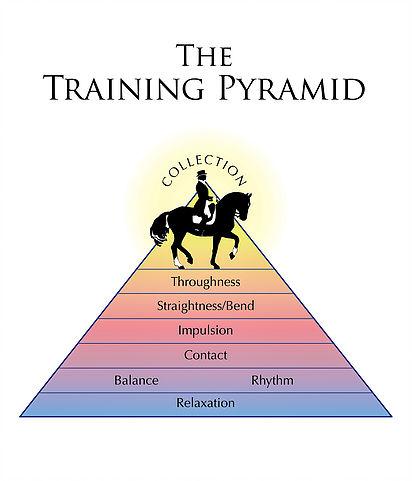
Chakras & the Training Pyramid, Part 6
The third eye chakra and throughness.
The sixth chakra is the third eye chakra. Third eye chakra is located on the forehead between one’s eyebrows. This chakra represents one’s intuitive abilities.

This illustration first appeared in the November 1997 issue of Dressage Today magazine (DressageToday.com). Used here with permission.
The third eye chakra is pure gold when it comes to working with horses, whether you ride or drive. Your ability to intuit what your horse is feeling, his anxieties, and his potential reactions will help you support him in positive ways throughout your riding career together.
“Intuition” is sometimes pooh-poohed as more voodoo than legit mind-sensing. And yet there are many ways we use “intuition” in our riding as well as our daily lives.
Some examples:
You’re driving down the interstate and glance in your rear view mirror. A car is traveling directly behind you, then moves over one lane, and promptly disappears from view. You intuitively know the car is still there, in one of those “blind spots” that modern vehicle manufacturers try to mitigate by designing better mirrors. Sure enough, a few seconds later, the car “reappears” and begins to pass alongside you. Intuition.
You’re dressing up for a lovely evening out, and that fancy pair of red heels you bought on sale two years ago would go perfectly with your outfit. You set the shoes out to wear and walk towards the bathroom cabinet to grab a couple of adhesive bandages. Why? Because each time you’ve worn those shoes in the past, they’ve blistered your heels. Memory provides the foundation upon which intuition advises you to take preventative measures beforehand so you can enjoy a fun evening instead of a recurrence of those painful blisters. Intuition.
This is the good news: one’s intuition can always be developed or enhanced.
The more horses you ride, the more varied the riding circumstances, the more your intuition will have memories to help guide you forward in a positive way.
Intuition, in this sense, is the ability to accurately predict potential outcomes, and then make choices to skew the possible outcomes towards the outcome you want.
For example:
You’re riding a young horse who lacks both experience and confidence. You’re riding in an outdoor arena with a fenceline nearby, and one fence post has a bluebird box on it. You know there are nesting birds using the box, so they will be flying in and out of the box throughout the day.
A “good” rider will be so relaxed, so focused, and so in control of their horse, they can handle a bird-induced spook successfully.
An intuitive rider, on the other hand, will also carefully school the horse closer and closer to the birdhouse so their green mount can become aware of the object before a wild winged friend pops out and slightly startles him. In this example, the rider’s intuition anticipated a potential negative outcome (the spook), and this allowed the rider to make choices and take steps to maximize the potential for a positive outcome (the slight startle).
Sometimes, riding with intuition is referred to as “riding with soft eyes.” If you breathe deeply and relax your vision, your peripheral view becomes more readily discernible to your brain, so you can note the rabbit that may dart out in front of you on the trail, or the papers riffling in the breeze at the judge’s box. In addition, you allow your memory-plus-predictability (i.e., intuition) to help guide you. This is the essence of the “third eye.”
When properly developed, one’s intuitive abilities can grow to the point where you can literally feel when your horse is tense or worried or playful or lonely, just by being in his general vicinity — without ever seeing his eye or sensing his muscles. Intuition — the ability to “feel” your horse’s “thoughts” — is one of the hallmarks of great horsemanship. At this level of training and development, all the various physical aspects of riding (e.g., heels down, shoulders back, chest lifted, soft hands, etc.) have merged into one “well-oiled machine” as a rider; our body has learned to ride well enough that we do not have to think about all the myriad minutia, but, instead, we can ride “intuitively.”
Riding with intuition is what allows your horse to develop throughness. A physical embodiment that can sometimes seem ethereal to describe, “throughness” is when the horse’s body and mind are working in such harmony, the animal’s various parts are one cohesive, elegant unit of physical movement and mental action. The horse is fully engaging his hind end (sometimes described as the horse’s “motor”) and pushing his body forward (or backward or any other direction of travel) as one harmonious athletic entity with each hind step.





Leave a Comment